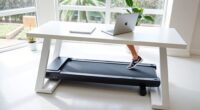To start run commuting, plan your route carefully using well-lit trails or sidewalks, and choose safe, manageable distances that match your fitness level. Invest in moisture-wicking clothes, supportive shoes, and safety gear like reflective accessories. Establish a routine by running at the same time daily, gradually increasing your distance. Stay motivated by tracking progress and enjoying the benefits. Keep these tips in mind, and you’ll discover more ways to make it a sustainable, enjoyable habit.
Key Takeaways
- Choose safe, well-lit routes with minimal traffic and hazards to build confidence and ensure safety.
- Use appropriate gear like moisture-wicking clothes, supportive shoes, and reflective accessories for comfort and visibility.
- Gradually increase your distance and maintain a consistent schedule to build endurance and establish a routine.
- Plan for post-run essentials like showers and change of clothes at your destination to streamline your commute.
- Stay motivated by tracking progress, celebrating milestones, and adjusting routes to keep the experience engaging.

Thinking about turning your daily commute into a run? It’s a great way to incorporate exercise into your busy schedule while saving time and reducing stress. But before you hit the pavement, you need to prepare properly. Starting run commuting requires some planning, especially around choosing the right running gear and mapping out a safe, efficient route. These first steps will set the foundation for a successful and enjoyable experience.
First, focus on your running gear. You’ll want comfortable, moisture-wicking clothes that keep you dry and cool during your run. Invest in a good pair of running shoes that provide proper support and cushioning—your feet will thank you after miles of pavement. Consider packing a small bag with essentials like a change of clothes, a towel, and toiletries so you can freshen up once you arrive at your destination. If you’re running in colder weather, layering is key; include a lightweight jacket or thermal gear to stay warm without overheating. Reflective accessories or bright colors are also important if you’re running early in the morning or late at night, ensuring you’re visible to others. Having the right gear not only makes your run more comfortable but also boosts your confidence, making it easier to stick with your new routine.
Choose moisture-wicking clothes, supportive shoes, layered outfits, and reflective gear for comfortable, safe run commuting.
Next, route planning is vital for a smooth run commute. Start by selecting a route that minimizes traffic and hazards while offering a safe, scenic pathway. Use online maps or running apps to identify routes that are well-lit and maintain good sidewalk or trail conditions. Keep your route manageable, especially in the beginning—aim for a distance that feels doable and leaves you enough time to shower and prepare for work afterward. It’s also helpful to vary your routes to keep things interesting and prevent boredom. If possible, choose routes that connect easily to your home and workplace, saving you time and reducing the likelihood of getting lost. Consider testing out your route during non-commuting hours first, so you can familiarize yourself with the terrain and identify any potential issues. Incorporating high-quality running shoes can significantly improve comfort and reduce injury risk over long distances. Planning ahead means you won’t waste time figuring out where to go, and you’ll feel more confident tackling your run commute daily.
Once you’ve sorted your gear and route, make a schedule that gradually increases your running distance. Start with shorter distances, and as your body adapts, build up to your desired length. Consistency is key—try to run at the same time each day to build a habit. Remember to stay hydrated, listen to your body, and give yourself time to rest if needed. With thoughtful preparation and a positive mindset, run commuting can become an enjoyable part of your routine, helping you stay fit while reducing your carbon footprint.
Frequently Asked Questions
What’s the Best Gear for Run Commuting?
The best gear for run commuting includes essential clothing layers that keep you comfortable and dry, like moisture-wicking shirts and a lightweight jacket for changing weather. Invest in good running shoes with support, and consider a small, secure backpack or waist pack for your essentials. Always carry reflective gear or bright clothing for visibility, especially in low light. This gear guarantees a smooth, enjoyable commute and helps you stay motivated.
How Do I Stay Motivated Long-Term?
Staying motivated long-term is like steering a ship through changing seas—you need steady goals and fresh motivational strategies. Keep your goals clear with specific, achievable targets, and celebrate small wins. Mix up your routes, listen to motivating podcasts, or set new challenges to stay inspired. Regularly revisiting your reasons for run commuting and tracking progress helps you stay on course, turning your routine into an exciting journey rather than a chore.
What Safety Precautions Should I Take?
You should prioritize safety by wearing proper safety gear like reflective clothing, a helmet, and lights, especially if running early mornings or at night. Always plan your route in advance, choosing well-lit, populated paths and avoiding isolated areas. Stay aware of your surroundings, carry a phone for emergencies, and let someone know your schedule. These precautions help keep you safe and confident as you enjoy your run commute.
How Do I Handle Weather Changes?
Did you know that 70% of runners change their route during bad weather? When weather changes, adapt by wearing seasonal clothing and planning your route accordingly. Layer up for cold or rainy days, and choose sheltered paths if possible. Adjust your start time to avoid storms and stay visible in low light. Flexibility and proper gear help you stay consistent, no matter the weather.
Can I Combine Running With Public Transportation?
Yes, you can definitely combine running with public transportation. Try integrating public transportation by planning your route with stops where you can run part of the way, creating a bike and run combo when biking is involved. Public transportation integration makes your commute flexible and efficient. This approach reduces travel time, saves money, and keeps your routine interesting, helping you stay motivated to run regularly.
Conclusion
Starting run commuting is like planting a small seed—at first, it’s just a tiny step, but with consistency, it can grow into a strong, healthy habit. I remember when I first began, I was doubtful but kept going, and now it’s my favorite part of the day. Just like watering that seed daily, sticking with your routine will help you build confidence and momentum. Keep going, and watch your new habit flourish over time.









